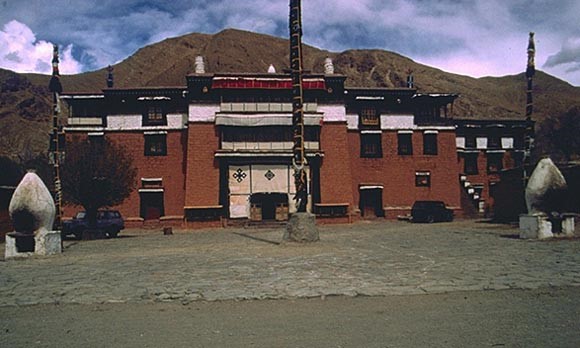The History of the Monastery
 The origins of Gongkar Choede began when Srijnana Atisha (Jowo-je) passed through the Yarpo area of central Tibet; he stopped a short distance from the present monastery and made a prostration. When his attendants asked him why he did so, the Master told them, "Look here! In the future your Lama will establish a great monastery here." The great pile of white stones marking the spot where Atisha offered a Mandala at the time of making this prophecy could be seen until the early 1960's.
The origins of Gongkar Choede began when Srijnana Atisha (Jowo-je) passed through the Yarpo area of central Tibet; he stopped a short distance from the present monastery and made a prostration. When his attendants asked him why he did so, the Master told them, "Look here! In the future your Lama will establish a great monastery here." The great pile of white stones marking the spot where Atisha offered a Mandala at the time of making this prophecy could be seen until the early 1960's.
In the Water Rat year of 1432, amid many wonderful signs, the great and much-renowned Dorje Dhenpa Kunga Namgyal was born into the excellent lineage of Thumi Sambhota, of which he was the 13th descendant. His father was Gyalwa Sherab and his mother was Palden Denma.
Following the tradition of his forefathers, Kunga Namgyal became the Dzongpon (governor) of the area of Gongkar Dzong when he was fifteen years old. His wish was to become a monk, but following the insistence of his mother, he married as a teenager and fathered heirs. At that time he received the vows of a lay devotee from his main Lama, Draktopa Soman Zangpo, along with many teachings, including the Sakya Lamdre.
The disciple of Lama Dampa Soman Gyaltsen who was known as Thekchen Chokyi Gyalpo (Kunga Tashi) was the chief holder of the Dzongpa tradition of the Sakya School. His disciple was Draktokpa Sonam Zangpo, and from him Dorje Dhenpa received full instruction. At the age of 26, he received higher monastic ordination from Je Jampa Lingpa (Sonam Namgyal) and studied the Kalacakra Tantra and the main fields of knowledge. It was only then that he received the name Kunga Namgyal.
With Shalu Yeshe Gyatso (1404-1473) he trained in most of the Tantric rituals, such as the Yoga Tantra's and so on. These were his three main Gurus. He also received a complete range of teachings on Sutra and Tantra from qualified masters of all traditions. Finally in 1474, at the age of 42, he took full (Bhikshu) ordination.
At the age of 33, in the Wood Monkey year of 1464, he founded the site of the present monastery upon auspicious signs and charged Chaturmukha Mahakala with its protection. The site was quite amazing. There was a heap of white stones offered in devotion at the time of Atisha's prophecy on the site; in the northwest, in the front of the site, was a gently, constantly flowing stream, in the manner of a water offering; to the north, was a peculiar cave, residence of the spirit Nagaraja, and the rear mountain resembled a Garuda alighting with its wings outstretched, so the monastery rested in the lap of a Garuda. Thus, on the strength of these and other perfect geomantic properties, following the pacification and ritual preparations of the ground through extensive and elaborate performances of the Varja Kilaya rites, the great monastery of Dorje Dhen was founded. The entire monastery was completed in one year. Most of the statues, murals and scroll paintings were executed at the wish of the great Dorje Dhenpa Kunga Namgyal by the master-artist Gongkar Khyentse Chenmo, the originator of the Tibetan painting style known as "Khyenri".
Here, Dorje Dhenpa Kunga Namgyal instituted the particular ritual, instruction and accomplishment program of the later Dzongpa tradition passed down by Thekchen Chogyal, also known as the Gongkar tradition. The empowerment's, transmissions and instructions for the ritual performance of some sixty-four mandalas were drawn from the four orders of Tantra. The vast and profound practices in their entirety were established along with the tradition of religious dance (cham). As a renowned and exemplary model of the teachings, he became a powerful upholder of the Sakya tradition in the province of Central Tibet.
At the age of thirty-three, he visited Sakya. As a master of the Sakya teachings, he was welcomed and accorded with no end of respect. His invocations of the Dharmapalas (Protectors) was beyond imagining and he was famed for his magical power. His writings were extensive. His deeds of spiritual power being very many, his reputation spread greatly. His tradition of instruction and accomplishment has continued for more than five hundred years uninterrupted since the monastery was founded, and the teachings remain unbroken in this present day.